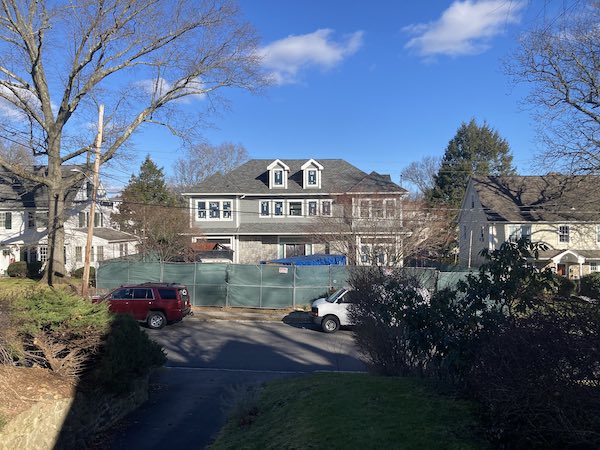BOT Moves to Scale Back the Scope of the Proposed Building Moratorium
- Wednesday, 20 December 2023 12:08
- Last Updated: Thursday, 21 December 2023 14:11
- Published: Wednesday, 20 December 2023 12:08
- Joanne Wallenstein
- Hits: 2901
 The Mayor appeared to be backing off from a controversial proposal for a building moratorium after receiving feedback from developers and realtors who feared the impact on their businesses.
The Mayor appeared to be backing off from a controversial proposal for a building moratorium after receiving feedback from developers and realtors who feared the impact on their businesses.
A draft of a proposed six-month moratorium on all building and land use applications was proposed at the November 14, 2023 meeting of the Board of Trustees. The rationale behind the moratorium was explained by Village Attorney Nicholas Ward-Willis as follows:
He said, “The improvements, subdivision and redevelopments on single-family lots have created a number of pervasive adverse impacts including but not limited to the loss of the architectural and historic qualities and scale that helps define the fabric of our residential neighborhoods as well as negative environmental impacts such as increased flooding and the destruction of mature trees and natural habitats. These impacts are resulting from, among other things, the rapid pace of demolitions and replacement of older homes, additions being built on single-family properties, the construction of accessory structures, and the subdivision and redevelopment of residential lots. Such development activities create new impervious surfaces thereby diminishing the natural drainage and flood mitigation provided by mature trees and open space. Our natural resources are finite and fragile, and the Village’s infrastructure and other public resources are increasingly being tested by more frequent and severe storm events.”
However responding to push back from the community, at a work session of the the Village Trustees on December 19, Mayor Justin Arest proposed more limited measures to tweak the building code to require modest reductions in the floor area ratios (FAR) or sizes of homes and in lot coverage.
Arest proposed the following for the period of the six month moratorium:
-Decrease the FAR (floor area ratio) to 95% of what is now permitted.
-Decrease the lot coverage (all impervious surfaces) to 90% of what is now permitted.
-Decrease the building coverage to 95% of what is now permitted.
-Potentially increase setbacks 10% to 20% depending on the building zone.
During this period hook-ups to the stormwater system would not be permitted from private properties.
Another new provision would require an expedited histsoric preservation review of all projects. Arest explained, "As for historic preservation, we want to prevent any potentially historic properties from having exterior alterations done to them that could impact their historic nature. Therefore, all exterior alterations that would not already require CHP review, would now require an expedited historic review process."
Explaining the rationale, Arest said, "The goal is to retain the benefits that a moratorium can provide the community as we undertake the holistic review of our code while limiting the negative impacts on homeowners ability to make improvements to their homes and lots," and “to find the right balance.” He said that planning consultants would be retained to analyze current code and propose changes.
Though the new proposal addresses home bulk it fails to take any action on the preservation of neighborhood character, historic preservation, height of new homes, subdivisions and the retention of Scarsdale’s trees, all of which originally brought residents to Village Hall with a petition. However, in the case of a subdivision, under these new rules, the two or three new houses built on the subdivided land would be reduced in size. This house on Tunstall Road was technically a renovation and now towers above its neighbors.
This house on Tunstall Road was technically a renovation and now towers above its neighbors.
Arest said he would ask the Village Attorney to redraft the moratorium language to reflect these changes and it would be posted on the Village website 10 days before a hearing scheduled for January 9, 2024. He anticipated that the Board would hold a hearing and vote on the resolution at the same meeting.
Discussing the proposal, Trustee Jeremy Gans said, “These proposed setbacks are substantially greater than any in any peer community. This would cause non-conformity.” He later said, “All of the discussion was about what happens when there is a teardown. Could we simply say no tear downs during this period.?” “Voting against the proposal, saying “I was hopeful we would find an area to attack – I think this is too broad. I think we should better define what we’re attacking and narrow the scope.” He added, "The Planning Board and staff have said that the notion that development adds to burden on our stormwater system is debatable. That’s not to say that development should continue unabated. But I’d like to avoid making assertions that are not backed by data that we currently have."
Trustee Karen Brew said, “I wonder if 95% on FAR and 95% on building coverage is enough.” Referring to data from the Village Planner about homes that received a Certificate of Occupancy in 2023 she said, “These projects were built to 90% and still appear incredibly bulky.”
Trustee Ken Mazer asked if “We could tighten the process to prevent the teardowns like the one that happened on Hampton Road.”
Trustee Dara Gruenberg said, “Concerning the Conservation Advisory Council report on trees, is there anything we can do to address the trees?” She suggested that the Village 2024-25 Village budget include an enforcement officer to confirm that replacement trees are planted.
The trustees agreed on the new proposal by a vote of 6-1. The draft will be posted on the Village website by December 29, 2023 and will be the subject of a hearing and a vote on January 9, 2024.







